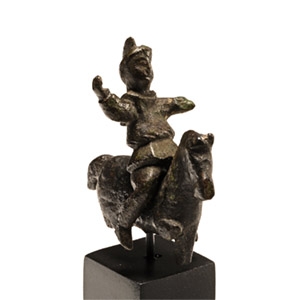Home > Auctions > 3 - 8 September 2024
Ancient Art, Antiquities, Natural History & Coins
Auction Highlights:
Identified as Roman by the British Museum on 8th January 1996.
From a collection acquired on the UK art market from various auction houses and collections mostly before 2000.
From an important Cambridgeshire estate; thence by descent.
Cf. Rolland, H., Bronzes Antiques de Haute Provence, Paris, 1965, items 34,37, for type.
From a collection acquired on the UK art market from various auction houses and collections mostly before 2000.
From an important Cambridgeshire estate; thence by descent.
Cf. Rolland, H., Bronzes Antiques de Haute Provence, Paris, 1965, items 77, 78, 81 for type.
From a collection acquired on the UK art market from various auction houses and collections mostly before 2000.
From an important Cambridgeshire estate; thence by descent.
Cf. Boucher, S., Recherches sur les Bronzes Figurés de Gaule Pré-Romaine et Romaine, Rome, 1976, item 274, for type.
From a collection acquired on the UK art market from various auction houses and collections mostly before 2000.
From an important Cambridgeshire estate; thence by descent.
Depictions of Apollo in association with the Omphalos usually show him seated upon it, as seen in the coinage of Antigonus I, circa 280-261 B.C.
London art market, 1992.
Cf. Rolland, H., Bronzes Antiques de Haute Provence, Paris, 1965, item 140, for type.
The figure represents either Silenus himself, the aged and semi-bestial companion of Dionysus, or a Seilenos - a member of the feral group of which he was the leader. The attitude of the figure, with the right arm extended and the head tilted, suggests that there should have been an accompanying female figure to whom Silenus was paying full attention. As a devotee of Dionysus, Silenus is often shown with Bacchantes, female celebrants in the cult of wine-drinking, music and other pleasurable pursuits.
From a collection acquired on the UK art market from various auction houses and collections mostly before 2000.
From an important Cambridgeshire estate; thence by descent.
Cf. Durham, E., Metal Figurines in Roman Britain, vol. 2, Reading, 2010, pl.124; see also Caesar (translated by S. A. Handford) The Conquest of Gaul, 1982.
The pose of the figure suggests that he is in the action of brandishing a weapon, or possibly holding the reins of a team of horses pulling a chariot. Caesar mentions the expert use of the war-chariot by the Britons (Conquest of Gaul, IV.33). The padded garment suggests a Celtic auxiliary in the Roman army.
Acquired from G. Rihani, 1987.
English private collection.
Accompanied by a copy of the purchase invoice, 2 July 1987.
Accompanied by an academic report by Dr Raffaele D'Amato.
This lot has been checked against the Interpol Database of stolen works of art and is accompanied by search certificate number no.12231-218595
Cf. a similar statue of a sleeping girl in Galleria Borghese, Rome, inv.no.XIV, 140-160 A.D. in Moreno, P., Stefani, Ch., Galleria Borghese, Milano, 2000, p.38, n.6a.
The girl shows exotic features, evocative of Roman North Africa, where a mixed Romano-Berber population lived in one of the richest provinces of the Empire. However, the hairstyle refers to those of the Antonine Dynasty, such as the portraits of the Empress Faustina the Elder. It represents probably a sarcophagus lid of a young noble girl, commissioned by her loving parents. Some restorations, today still visible, were done in ancient times: an iron rod at the feet for reinforcement, the armilla on the right arm sculpted at a later stage, the hole in the ear for the insertion of a lost metal or glass earring, the upper part of the head restored in antique with a portion of Parian marble. The sculpture is a Roman work, but it was inspired by a Hellenistic model, probably from Pergamon.
Private collection, England.
Accompanied by an academic report by Dr Raffaele D'Amato.
This lot has been checked against the Interpol Database of stolen works of art and is accompanied by search certificate number no.12232-215644.
Cf. similar statue of Asclepius in the Borghese Collection (Inventario Fidecommissario Borghese, 1833, C., p.51, no.149).
Acquired from Simon Shipp, circa 1997.
Believed to be published in an old Den of Antiquity catalogue.
From an important Cambridgeshire estate; thence by descent.
Cf. Boucher, S. & Tassinari, S., Musée de la Civilisation Gallo-Romaine a Lyon: Bronzes Antiques I. Inscriptions, Statuaire, Vaisselle Lyon, 1976, items 47, 50, for type.
Identified by the British Museum as depicting Oceanus on 8th January 1996.
From a collection acquired on the UK art market from various auction houses and collections mostly before 2000.
From an important Cambridgeshire estate; thence by descent.
Accompanied by a copy of the British Museum letter dated 8th January 1996.
From a collection acquired on the UK art market from various auction houses and collections mostly before 2000.
From an important Cambridgeshire estate; thence by descent.
Cf. Boucher, S., Recherches sur les Bronzes Figurés de Gaule Pré-Romaine et Romaine, Rome, 1976, item 354, for type.
From a collection acquired on the UK art market from various auction houses and collections mostly before 2000.
From an important Cambridgeshire estate; thence by descent.
See Rolland, H., Bronzes Antiques De Haute Provence, Paris, 1965, items 400-401, for similar.
73 - 84 of 3369 LOTS

.jpg)

.jpg)
.jpg)
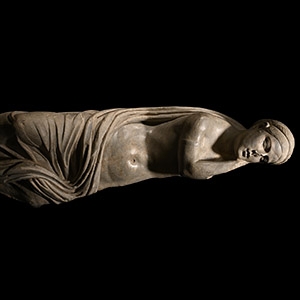
.jpg)
.jpg)



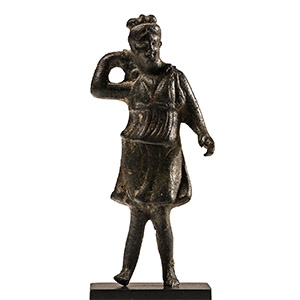
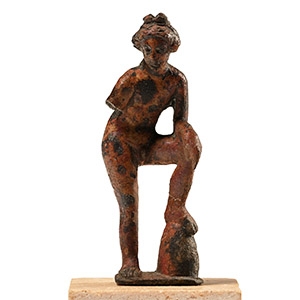
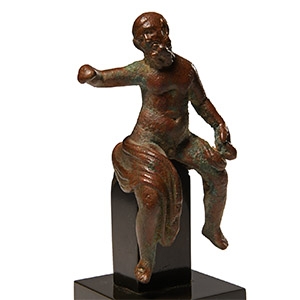
.jpg)
.jpg)


